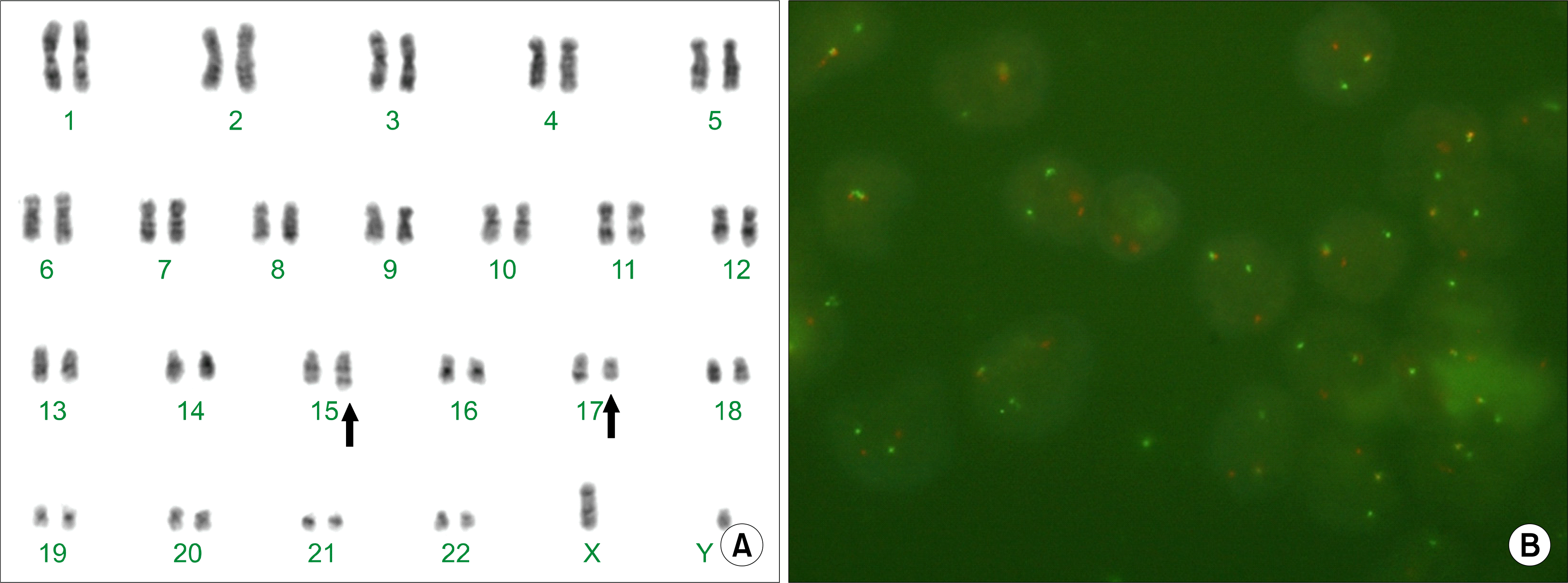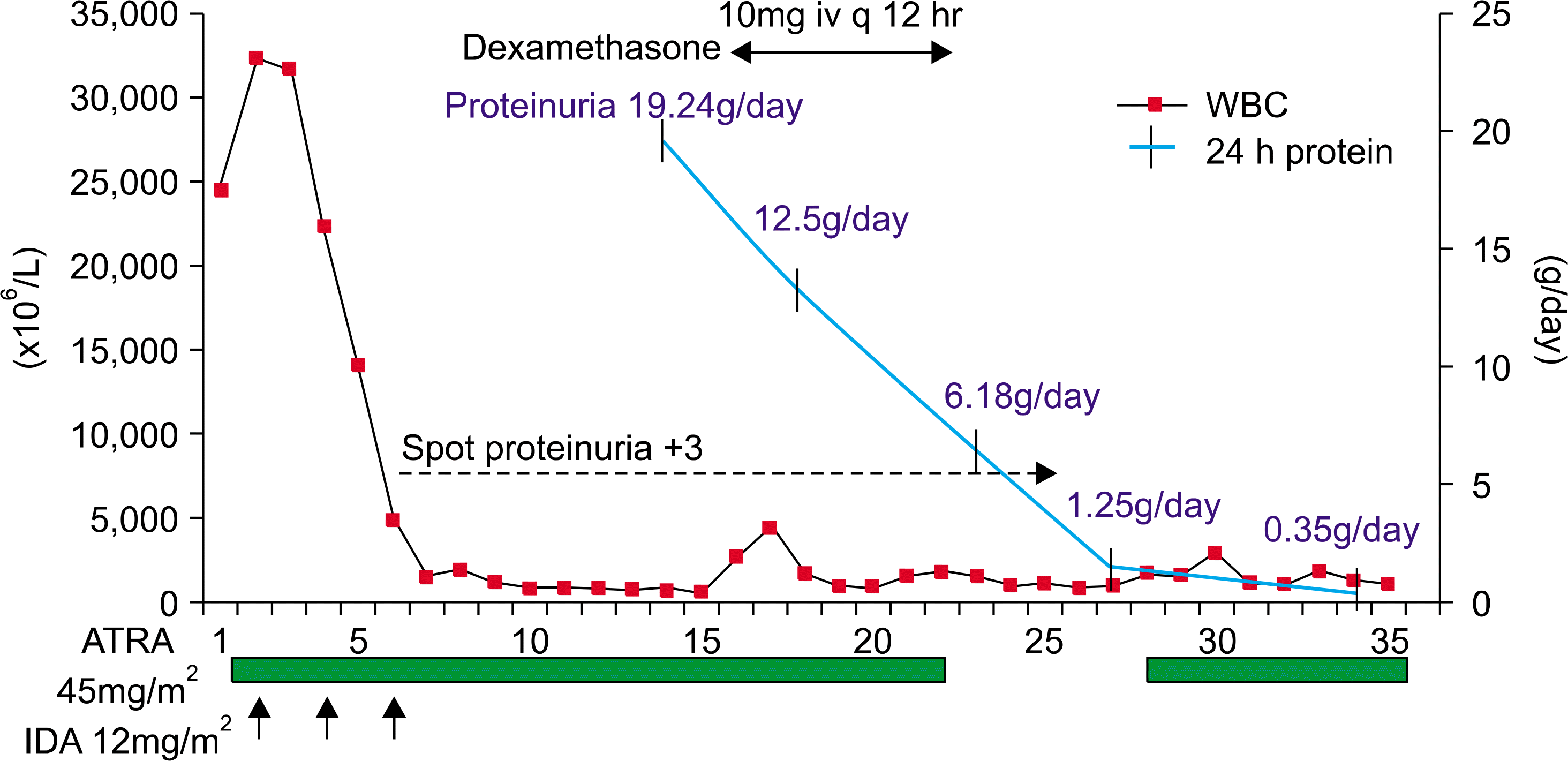Abstract
All-trans retinoic acid (ATRA) is a potent differentiating agent for the treatment of acute promyelocytic leukemia (APL). Although ATRA is generally well-tolerated, some patients develop side effects, the most severe of which is ATRA syndrome. We report on a patient with APL who developed isolated nephrotic-range proteinuria during ATRA therapy for remission-induction. ATRA was discontinued and the proteinuria decreased significantly 5 days after dexamethasone treatment. The occurrence of isolated proteinuria during ATRA treatment is a rare adverse event.
REFERENCES
1). Warrell RP Jr., de Thé H., Wang ZY., Degos L. Acute promyelocytic leukemia. N Engl J Med. 1993. 329:177–89.

2). Lengfelder E., Reichert A., Schoch C, et al. Double induction strategy including high dose cytarabine in combination with all-trans retinoic acid: effects in patients with newly diagnosed acute promyelocytic leukemia. German AML Cooperative Group. Leukemia. 2000. 14:1362–70.
3). Tallman MS., Andersen JW., Schiffer CA, et al. All-transretinoic acid in acute promyelocytic leukemia. N Engl J Med. 1997. 337:1021–8.

4). Sanz MA., Martín G., Rayón C, et al. A modified AIDA protocol with anthracycline-based consolidation results in high antileukemic efficacy and reduced toxicity in newly diagnosed PML/RARalpha-positive acute promyelocytic leukemia. PETHEMA group. Blood. 1999. 94:3015–21.
5). Fenaux P., Chastang C., Chevret S, et al. A randomized comparison of all transretinoic acid (ATRA) followed by chemotherapy and ATRA plus chemotherapy and the role of maintenance therapy in newly diagnosed acute promyelocytic leukemia. The European APL Group. Blood. 1999. 94:1192–200.
6). Astudillo L., Loche F., Reynish W., Rigal-Huguet F., Lamant L., Pris J. Sweet's syndrome associated with retinoic acid syndrome in a patient with promyelocytic leukemia. Ann Hematol. 2002. 81:111–4.

7). Charles KS., Kanaa M., Winfield DA., Reilly JT. Scrotal ulceration during all-trans retinoic (ATRA) therapy for acute promyelocytic leukaemia. Clin Lab Haematol. 2000. 22:171–4.

8). Martínez-Chamorro C., Martínez E., Gil-Fernández JJ., Alonso A., Escudero A., Fernández-Rañada JM. ATRA-induced myositis in induction therapy of acute promyelocytic leukemia. Haematologica. 2002. 87:ECR08.
9). Frankel SR., Eardley A., Lauwers G., Weiss M., Warrell RP Jr. The "retinoic acid syndrome" in acute promyelocytic leukemia. Ann Intern Med. 1992. 117:292–6.

10). De Botton S., Dombret H., Sanz M, et al. Incidence, clinical features, and outcome of all transretinoic acid syndrome in 413 cases of newly diagnosed acute promyelocytic leukemia. The European APL Group. Blood. 1998. 92:2712–8.
11). Larson RS., Tallman MS. Retinoic acid syndrome: manifestations, pathogenesis, and treatment. Best Pract Res Clin Haematol. 2003. 16:453–61.

12). Flombaum CD., Isaacs M., Reich L., Berman E., Warrell RP. Acute renal failure associated with the retinoic acid syndrome in acute promyelocytic leukemia. Am J Kidney Dis. 1996. 27:134–7.

13). Tomita N., Kanamori H., Fujita H, et al. Granulomatous tubulointerstitial nephritis induced by all-trans retinoic acid. Anticancer Drugs. 2001. 12:677–80.

14). Sastre A., Gago E., Baños M., Gómez E. Acute renal failure in the transretinoic syndrome. Nefrologia. 2007. 27:184–90.
15). MiróO. Nadal P., Nomdedeu B., Sacanella E. Transitory proteinuria during treatment with tretinoin. Med Clin (Barc). 1995. 104:439.
Fig. 1
Cytogenetic and dual color fluorescence in situ hybridization (FISH) analysis. (A) Cytogenetic analysis of the bone marrow showed a t(15;17)(q22;q24) in all metaphases. (B) This translocation between chromosomes 15 and 17 was also detected in 94% of the bone marrow cells by dual color, single fusion method of FISH analysis.

Fig. 2
Time sequence of clinical features. Dexamethasone was started on day 15; the 24-hour proteinuria then decreased to 12.5g/day. However, the spot urine protein remained >300mg/dL and the ATRA was subsequently discontinued on day 22. The concentration of the 24-hour protein decreased gradually. Dexamethasone was discontinued on day 23.





 PDF
PDF ePub
ePub Citation
Citation Print
Print


 XML Download
XML Download